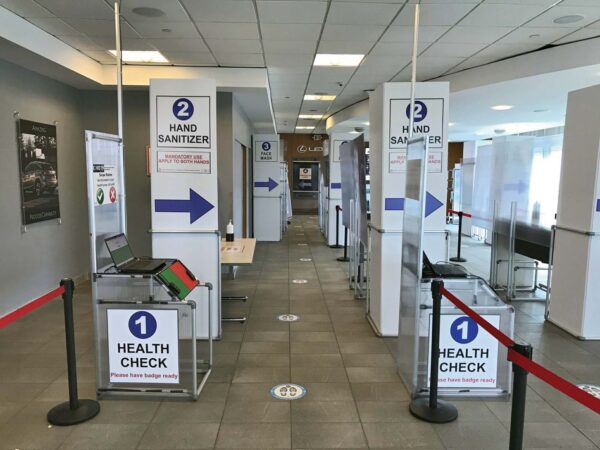
Back to work: It’s safety first at TMMC’s assembly plants
By JOE TERRETT, EDITOR
Industry Automotive Manufacturing COVID-19 Safety TMMC ToyotaGHD helps the automaker ramp up and discusses effective measures.

Employee screening at TMMC plant entrances. PHOTO: TMMC
Canadian manufacturers are in the process of easing their operations into revival mode as the nation emerges from the COVID-19 pandemic. Among these are the large-scale, automotive manufacturers. They took steps in May to begin carefully ramping up production after shutting down in March to protect employees and align with plummeting demand for vehicles during the crisis.
Toyota Motor Manufacturing Canada Inc. (TMMC) opened its doors at the Cambridge and Woodstock, Ont. plants to its 8,500 employees after prepping the sites with procedures and safety equipment that will protect against an outbreak of the virus. Helping TMMC with this task is GHD, a global engineering firm based in Waterloo, Ont.
TMMC has a COVID task force and plenty of resources to apply against a COVID incursion, but the automaker’s efforts provide some basic guidance for other manufacturers with much less to work with.
For GHD, it’s about responding, recovery and especially long-term resiliency, the last point a theme GHD vice-president Jason Haelzle emphasizes as manufacturers such as Toyota move forward. “Those who survive this challenge are going to come out much stronger, more resilient and more agile than they were coming into it.”
The automaker is clear its primary concern is the safety of employees and the community. As such, Haelzle has been working with TMMC management from the president and executives to senior managers on the employee-screening piece of the recovery phase.
TMMC has set up controlled and spaced entryways into its facilities where it assembles RAV4 and Lexus models. Everyone is provided with face masks for use at all times while on site. Employees fill out a daily questionnaire to determine if anything has changed day-to-day, and each person’s temperature is checked using thermal cameras. A temperature reading above a set limit requires a second test. This interlocks with other safeguards such as sanitizing, personal protective equipment (face shields, gloves and hand-sanitizer), barriers, signage and the alignment of employee movement to ensure social distancing is maintained.
The plants were assessed and changes made to accommodate physical distancing, physical separation and use of enhanced PPE while working, during all breaks, and while entering or leaving during shift changes. Cleaning processes were also enhanced, with high traffic areas such as break rooms and restrooms getting more frequent attention.
These protocols continue indefinitely, with ongoing monitoring and Toyota says it will make changes based on federal, provincial and municipal public health recommendations.
Manufacturers conducting temperature screening have done so manually from the ear, but Haelzle says thermal imaging cameras allow rapid throughput and are capable of taking images. If a high temperature is detected, there’s also a capability to tie in with swipe cards to prevent access. To ensure efficacy of the data, parallel testing of ear readings and thermal imaging are compared.
Whatever the size of the plant, getting back to business and building in long-term resiliency requires a layered approach that includes measures similar to those employed by TMMC. Haelzle likens it to stacking slices of Swiss cheese. They’re connected but the holes don’t line up.
“Any one of those [measures] adds value, but on their own, they’re not anywhere near as effective as integrating the whole solution,” he says. “The connected worker and social distancing is the end-piece that leads to resiliency planning for the long term.”
Moving people
About the connected worker: that’s the essence of GHD’s Movement Strategies offering, which the engineering firm has been pitching to automotive companies. It’s a technology that comes from a UK company (same name) specializing in crowd dynamics and people movement in busy places. GHD acquired the firm in January.
The connected workforce is real-time social distancing that could be, for example, an audible signal letting employees know they are getting too close. Part of that is contact tracing by gathering movement data. This reveals high contact areas within a facility. Depending on plant requirements, employees wear a fob connected to a swipe card or RFID tag and sensors do the rest. The technology is capable of analyzing large data sets from mobile phone networks, wireless networks, smart cameras and other sources.
“We’re constantly seeing close interactions in hallways leading to the cafeteria or in the line during initial screening. These are all areas you can modify,” Haelzle says.
“The data is anonymous except, if someone is sick from COVID or has a fever, you do contact tracing to see who he/she had close contact with. [They] then go for testing and that limits the shutdown to exposed areas rather than the entire facility.”
Small and medium-size enterprises don’t have the deep pockets of a large company but there are steps they can take to establish what the new normal will look like post pandemic.
Haelzle says it will require some modelling and in-house expertise in hygiene and engineering or plant operations, to understand where there is close contact and how to eliminate it. Some GHD clients are using digital twinning to see how modifications will work before the capital is invested.
Haelzle expects to see more automation in plants, and hits to supply chains during the crisis have exposed weakness that will lead to onshoring some of that business.
Yes, there will be a cost, but he offers a pragmatic view. “What does the solution look like compared to shutting your facility down for a day, a week or a month?”
Haelzle sees companies that adapt and put team safety first ending up stronger and finding their way back to growth quicker than those who neglect their long-term resiliency.
This article originally appeared in PLANT Magazine’s May-June 2020 print issue.
